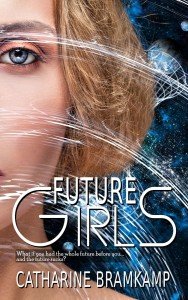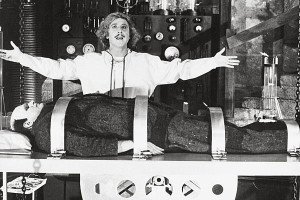How to Predict the Future – Creating the Science Fiction Novel by Catharine Bramkamp
 Let’s welcome back monthly columnist Catharine Bramkamp as she shares with us about “How to Predict the Future – Creating the Science Fiction Novel.” Enjoy!
Let’s welcome back monthly columnist Catharine Bramkamp as she shares with us about “How to Predict the Future – Creating the Science Fiction Novel.” Enjoy!
***
“We live in a society exquisitely dependent on science and technology, in which hardly anyone knows anything about science and technology.”
–Carl Sagan (1934 – 1996)
Many writers are not specifically or even self identified, scientists. Yet we write about science and technology anyway. Why? Because we use it –technology, and we depend on science. Many of us watched Star Trek as kids. What else is there to know?
But a story that is just about science isn’t a story, it’s a list of weird useful stuff, like the show catalogue for CES.
Writing about the future is less about technology and far more about plot. If you’ve ever read a tech heavy story (that is often little more than a list of, well, you know, tech), you understand the problem.
The Future in Your Story
Your main character is not living in the future, she is living in her present.
That is part of tension in science fiction — the fantastic inventions of the future reduced to the frustrations of the present. Ever since George Lucas created alternative worlds packed with dusty rotting computers and hyper-drives we’ve been able to visualize the future not as always clean and organized, like the bridge of the USS Enterprise, but as dusty and junky, a ship made of as many random parts as fools. We bang on the hood of the hovercraft and swear at the all the bad flyers out in the sky today.
Our heroine scrolls through five hundred satellite channels while complaining there is nothing on.
Normalize the Fantastic
We don’t think about modern life as the future because it’s annoying us right now. Same for your characters. Normalize the fantastic, make the future part of the plot, or give technology or lack thereof, a hand in the crisis point, make it a joke or an aside. Just not the whole reason for the story. Even I, Robot had something else to do.
Once the essential plot is established, often Man versus the Machine, it seems a shame to waste all our perfectly good predictions.
How can science and technology influence the story?
What is the trade off for all this great technology?
Detail the best, most recent advances in science and/or technology and consider the exchange.
What do we give up for convenience?
What do we sacrifice for immediacy?
Are hundreds of entertainment channels necessary, a joy, or just more work to wade through?
Like Margaret Atwood pointed out in Handmaid’s Tale, what if all our electronic credit and bank cards were revoked?
Can we escape the all-encompassing systems we’ve created in the name of quick check outs?
What if Technology is the problem, not the answer?
Take that idea — what is lost — and expand on it.
What if, every evening, the hapless heroine came home from work and had to do the work of finding exactly the right, trendiest show to watch, and if she wastes her time watching something that isn’t “hip,” will she be called out on it at work the next day? And what are those consequences? What if she doesn’t care because there is something strangely compelling about the show she is drawn to. What if every one in her social group is expected to watch the same kinds of show, or even the same show — but she doesn’t?
And what happens when she meets someone else who is a fan of this obscure, Channel 3,450 show?
You’ve used a basic technology question — helping identify the book or story as science fiction, but grounded it in human and classic plot lines.
 Frankenstein, the first science fiction novel
Frankenstein, the first science fiction novel
Mary Shelly did just that when she wrote Frankenstein in 1818.
Frankenstein is considered the first science fiction novel. Shelly invented her story by using the new, new thing of the time: electricity.
In its first iterations, electricity was applied to many things, animals and humans being two of them. Experiments were being done to re-animate body parts using electrical currents.
Scientist like Giovanni Aldnini applied electrical currents to body parts to stimulate them into life-like movements. He even applied electrical currents to the severed head of a recently executed criminal. (I know what you’re thinking, Abby Normal):
“This stimulus produced the most horrible contortions and grimaces by the motions of the muscles of the head and face; and an hour and a quarter after death, the arm of one of the bodies was elevated eight inches from the table on which it was supported, and this even when a considerable weight was placed in the hand.” — http://www.lateralscience.co.uk/reanim/galvreanim2.html
Gruesome stuff. Shelly took those experiments to the next level: what if a student reanimated a whole person? And how would the creature himself feel about it?
Take ideas and inventions to the limit, that’s what science fiction writers do.
They wonder about dreaming of electric sheep. They imagine Death Stars and red planets.
Try it yourself, pick a technology, pull out ideas from magazines and sites like Science Magazine, Science Daily, How Things Work, Popular Science, Scientific American.
What strikes you?
What technology do you think may go horribly wrong?
That’s how you start what can become a great science fiction story.
***
ABOUT THE AUTHOR
 Popular author, award winning poet, podcaster, champion of Newbie Writers everywhere, Catharine Bramkamp is the co-producer of Newbie Writers Podcast that focuses on newer writers and their concerns. She is a successful writing coach and author of over a dozen books including the YA Science Fiction Future Girls and the sequel, Future Gold (July 2015) .
Popular author, award winning poet, podcaster, champion of Newbie Writers everywhere, Catharine Bramkamp is the co-producer of Newbie Writers Podcast that focuses on newer writers and their concerns. She is a successful writing coach and author of over a dozen books including the YA Science Fiction Future Girls and the sequel, Future Gold (July 2015) .
Links:
Web site: http://www.YourBookStartsHere.com
Web site/blog: http://www.NewbieWriters.com
Podcast: The Newbie Writers Podcast
Twitter: @cbramkamp
FB: https://www.facebook.com/catharine.bramkamp
Pinterest: http://www.pinterest.com/cbramkamp/






